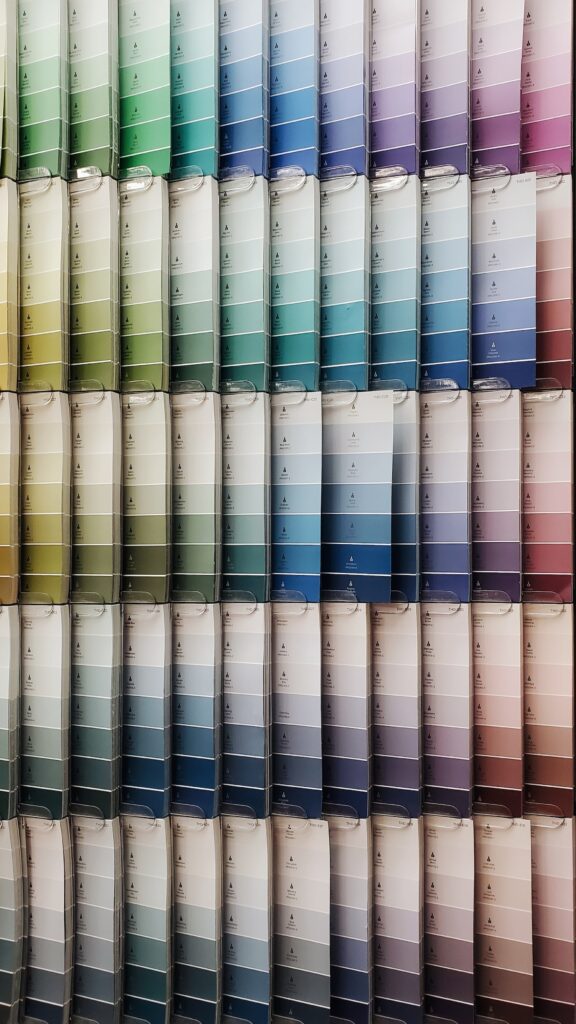In this week’s post, we are walking you through how to pick paint colors. This is one of the trickier pieces to get right in a home improvement project and is a question that comes up very often.
Variables such as natural vs. artificial light, adjacent finishes, and room direction can make a color look very different on-site than in the paint fan making what seems like a simple task, daunting and frustrating.
Don’t lose all hope! If you follow the steps outlined below, we guarantee you will find more joy in the process and be rewarded with a successful result. Let’s jump in!
Design Concept
Before you get started, make sure you have a clear understanding of the overall feeling you are trying to evoke AKA what is your design concept?
Are you looking to create a cheerful and uplifting space filled with personality? Or a spa-like escape filled with soothing blues and neutrals?
Determine this first and foremost so you know what you are looking for, this will also naturally narrow things down for you.
As designers say, practice safe design, always use a concept 😉

Understand Undertones
Let’s start with the basics, all colors have a warm or cool undertone. Warm undertones will have hints of red, yellow, or orange while cool undertones will have hints of blue, green, or purple.
I’m sure you have heard the terms “that is a cool white” or “that is a warm white”, these statements refer to the undertones of the color – whether it leans more blue or more yellow.
Warm tones generally create more energy while cool colors are more calming.
Remember that it doesn’t have to be all or nothing! We predict the combination of warm and cool tones to be a prevalent 2024 Interior Design Trend. You can have a cooler paint palette and still sprinkle in warmer elements in finishes, furniture, and accessories.
We recommend incorporating both warm and cool tones as a space with only one or the other can feel sterile and unwelcoming.

Pick Your Paint Colors On-Site, In The Proposed Space
Next pick up a paint fan, or multiple paint chips so that you have options to play with.

Keep in mind that a paint color that you love at the store may look entirely different when in your space. Bring samples home with you so you can review them in the proposed space in the actual lighting and site conditions.
When making paint color selections, consider any existing finishes or fabrics within the space to ensure the colour complements and feels good.
If you are making other cosmetic changes, make sure you have all your proposed finishes or fabric available so that you can view the paint chips in context with the rest of the finishes that will be in the space.
Colors pull different undertones depending on what they are adjacent to so make sure you are double-checking all adjacencies and possibilities.
Wall Color vs. Trim & Door Color
We are often asked whether the paint and trim should be lighter or match the wall color. The answer is that it depends on the overall look and feel you are going for – everyone’s favourite answer 😊.
Traditionally trim is white adding contrast between the wall and millwork elements. We love this fresh and clean look, but it often leads to the next question, what if your wall color is white?
Interestingly the sheen difference between walls and trim, typically eggshell for walls and semi-gloss for trim, can make the trim and wall color look different even if they are the same color.
BUT there is no rule saying that trim must be white. We are increasingly seeing darker trim combined with lighter walls which we are quite smitten with.
Whatever you gravitate towards, it all comes back to picking complimentary undertones to ensure both the wall and trim color feel good and play nice.
Swatch It Or Get Large Samples
Once you have narrowed down your selections, the next step is to paint or get a larger sample.
It may be tempting to skip this step, but a paint chip is simply not big enough to give you a full representation and feel of the colour. We always order larger samples for our clients or create them if needed.

We guarantee that taking the time to go through this process will provide clarity and instill confidence in your final decision.
You have a couple of options for larger paint samples:
- You can purchase peel-and-stick paint samples or
- Grab a sample pot from your paint supplier and paint a swatch on the wall or
- Use a sample pot to paint the poster board so you can move the sample around
We recommend painting swatches on a white wall or background as it ensures your eye is seeing the purest form of the color.
Once your swatches are complete, take some time to review and see what colors you are drawn to, and which ones are feeling off.
Always trust your gut, if a color seems a bit off you won’t be happy with it once the entire space is painted so be ruthless and eliminate it.
You may discover that you must pick up more paint chips or bust out the paint fan one more time.
Paint color selection is a process so don’t rush it and don’t be afraid to pivot if needed.
Keep your samples up for a few days and review them during different times of the day. Once you have lived with them for a few days, it will become clear which ones are working and which ones are not.
Pick The Right Paint Finish
You’ve done your homework, made your final decision, and now you are ready to pick up the paint. But wait! There is one more critical step to ensure paint longevity and durability.
Before you order, consider the below Paint Finish guidelines:
Use Flat for ceilings. Why?
There is no sheen, and the paint does not reflect light allowing it to mask imperfections.
Eggshell for walls. Why?
We all know that walls are exposed to their fair share of fingerprints and grime, so this subtle, soft sheen makes them easier to clean. Opting for this finish will give you longer-term durability.
Semi-gloss for trim, cabinetry, and doors. Why?
The higher sheen highlights architectural details and adds depth. The increased sheen makes for easier cleaning.
It may not seem like that big of a deal, but selecting the correct paint finish is critical to ensure your paint stands the test of time and looks good for longer.
For example, walls painted in a flat finish will be much more difficult to clean and will not hold up well to scrubbing resulting in scuffs, and scratches requiring a redo.
Don’t be afraid to ask questions and rely on your local paint supplier’s guidance and expertise to ensure the finish you select makes sense for the space and for you and your family.
How To Pick Paint Colors: Wrap Up
There you have it, the detailed process of how to pick paint colors. What seems like a fairly simple selection can take some time, but we are confident if you follow the process outlined above, you will be rewarded with a successful result.
Cheers!

Have you narrowed down paint selections but need a second opinion before committing? We would love to help! Get in touch with us.


